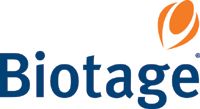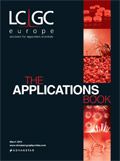Urinary Cortisol Extraction Using Supported Liquid Extraction Prior to LC–MS–MS Analysis
The Application Notebook
Biotage AB
This application note demonstrates an effective and efficient supported liquid extraction (SLE) protocol for the clean-up of urinary cortisol prior to analysis by gas chromatography–mass spectrometry (GC–MS). ISOLUTE SLE+ Supported Liquid Extraction columns offer an efficient alternative to traditional liquid-liquid extraction (LLE) for bioanalytical sample preparation, providing high analyte recoveries, no emulsion formation and significantly reduced sample preparation time.
Extraction Conditions
Plate configuration: ISOLUTE SLE+ 200 μL Supported Liquid Extraction Plate, part number 820-0200-P01.
Sample pre-treatment: Dilute sample 1:1 (v/v) with water.
Sample loading: Load the pre-treated sample (200 μL) onto the plate and apply a pulse of vacuum (VacMaster 96 Sample Processing Manifold, 121-9600) or positive pressure (PRESSURE+ 96 Positive Pressure Manifold PPM-96) to initiate flow. Allow the sample to adsorb for 5 min.
Analyte extraction: Apply methyl tert-butyl ether (MTBE) (1 mL) and allow to flow under gravity for 5 min. Apply vacuum or positive pressure to pull through any remaining extraction solvent, collecting into collection plate.
Post-extraction: Evaporate the extract to dryness (40 °C) (SPE Dry 96 Sample Concentrator SD-9600-DHS-EU). Reconstitute in water:methanol (50:50, v/v) (100 μL).
HPLC Conditons
Instrument: Waters 2795 Liquid Handling Unit (Waters, Milford, Massachusetts, USA)
Column: Phenomenex core shell Kinetex C18 2.6 μm, 50 × 2.1 mm (Phenomenex, Macclesfield, UK)
Mobile phase: 2 mM NH4OAc/0.1% formic acid (aq) (A) and 2 mM NH4OAc/0.1% formic acid in MeOH (B) at a flow rate of 0.2 mL/min

Mass Spectrometry Conditions
Instrument: Waters Ultima Pt triple quadrupole mass spectrometer (Waters, Manchester, UK) equipped with an electrospray interface
Monitored transitions: Positive ions were acquired using multiple reaction monitoring (MRM): Cortisol quantifier, 363.1>121.00; Cortisol Qualifier 1, 363.10>97.10; Cortisol Qualifier 2, 363.10>309.10; Cortisol-d4, 367.30>121.00.

Figure 1: Cortisol calibration curve (lyophilized urine) 25â2000 ng/mL. Chromatogram at 25 ng/mL.
Results
The method demonstrated high reproducible recoveries 99–101% (n = 7) with all relative standard deviations (RSDs) below 10%. The limit of quantitation (LOQ) was calculated as 25 ng/mL when compared to the calibration curve using lyophilized urine, which showed excellent linearity. Low ion suppression was observed, allowing LOQs below the therapeutic range from 100 μL of urine.
Conclusions
This application note presents a simple method for the extraction of cortisol from urine demonstrating high recoveries, low ion suppression and acceptable validation parameters.
For more information on this or to view any of Biotage's extensive database of sample preparation applications please visit http://www.biotage.com/applications or scan the QR code with your smart phone to go direct.

Biotage AB
Vimpelgatan 5, Uppsala, Sweden
tel. +46 18 56 59 00 fax +46 18 59 19 22
Email: info@biotage.com
Website: www.biotage.com

New Method Explored for the Detection of CECs in Crops Irrigated with Contaminated Water
April 30th 2025This new study presents a validated QuEChERS–LC-MS/MS method for detecting eight persistent, mobile, and toxic substances in escarole, tomatoes, and tomato leaves irrigated with contaminated water.

.png&w=3840&q=75)

.png&w=3840&q=75)



.png&w=3840&q=75)



.png&w=3840&q=75)










